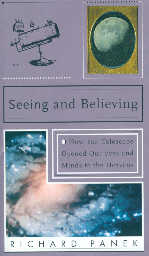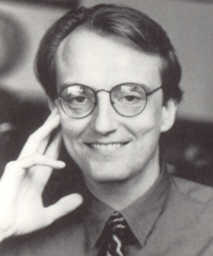And he set about calculating the distances to the stars, which task the accuracy of astronomical
methods of the time were not up to. One brilliant English astronomer, James Brady, while noting his
lack of success of measuring the distance to the stars, calculated what the distance to the nearest star
would be if it were possible to calculate it. His estimate of 36 trillion miles or 6 light-years was within
an order of magnitude. We were getting very close. Brady then discovered the light-gathering
properties of a parabolic surface and measurements got much closer. Something else also happened:
Herschel began to understand that the more light one gathered, the deeper into space one could look.
The increase in magnification of telescopes began to take a secondary place to the increases in their
light-gathering ability. Soon Herschel was able at the age of 76 to make the following mind-boggling,
for the time, statement:
[page 119] "I have observed stars of which the light, it can be proved, must take
two millions years to reach the earth."
At the beginning of the 20th Century the universe was one galaxy big; before it could grow any
bigger it would take men like George Ellery Hale crying, "More light!" He supervised the building of
the Yerkes telescope and the Mount Wilson observatory in his search for more light. And as the more
light began to pour through the eyepieces the astronomers began to discover strange colored patches
of light they called nebulae from the Latin word for "cloud." The first list of nebulae was compiled by
Charles Messier who found them to be a nuisance. He only recorded them to keep from mistaking them for comets, which he searched for earnestly.
In the quest for more light, William Herschel's son John came up with a new technology called
photography. As a pioneer in the field, John Herschel gave birth to the following names that we use
today: negatives, positives, and snapshots. Photography was frowned upon by true astronomers, but not
for long because a long exposure on a photographic plate accumulated more light than the eyes of an
astronomer could absorb.
But even with the photographic plates the light that was gathered was in the form of images.
All that would change when in the summer of 1854, William Huggins directed his telescope to the
nebula in Draco and received a single bright line spectrum in his spectroscope. That could only mean
that the nebula in Draco was a luminous gas! The birth of astrophysics, Panek tells us on page 137, can
be traced back to that night. No longer would the information from astronomical viewing be solely
visible images, but also the output of instruments from then on.
Hubble in 1929 noted from his instruments that the distances to nebulae outside of our galaxy
had an interesting correlation to the amount of redshift: the farther the distance to the galaxy, the
greater the redshift. The universe appeared to be expanding in all directions.
Soon the outputs of instruments such as radio receivers were being made into images and
correlated with the visible images from telescopes. Pulsars produced radio waves. Plus the radios were
picking up a hiss that had a period of 23 hours and 56 minutes. That is the length of a sidereal or astral
day the amount of time it takes the stars to circle the Earth. The 4 minutes represents the one degree
of the Earth's orbit around the Sun that it passes during a single day, allowing the stars to complete
their rotation before the Earth has completed its full rotation. It was Karl Jansky, working for Bell Labs
in 1934, who first noted the hiss and its sidereal basis. The stars were sending radio waves to Earth
from all directions. What was going on in the heavens? And most of all, what was going on in the
minds of astronomers? More opening, perhaps?
[page 157] For hundreds of years astronomers had been playing with light -
seeking it, losing it, bouncing it, bending it, timing it, gathering it, scrutinizing it.
As of the mid-nineteenth century and the advent of photography, they'd begun
accumulating it. Now they were even redefining it, for the time had come that
further headway would be difficult unless everyone could first agree on the first
fundamental source of information, light itself: What was it?
What it was, was a small part, less than two percent of the electromagnetic spectrum, any
portion of which was becoming readable in our new instruments and thus a source of information about
the universe in the sky around us. Geiger counters could map the sources of X-rays in the universe.
Here's the list: radio, infrared, optical ultraviolet, X-ray, and gamma rays all of them had something
to tell us about the universe if we cared to look at that part of the electromagnetic spectrum. If we
looked at the heavens with radio waves, we found pulsars those dead, collapsed, rotating stars. If we
looked with infrared, we found cool, very old stars. If we looked with X-ray, we found hot, new stars.
Some of the objects formerly thought to be stars were found to be well outside our galaxy and radiating
as much energy as millions of our Sun they could only be called quasi-stellar radio sources or
quasars, a name given as much to our ignorance of their status as anything. And the eeriest objects of
all were the X-ray sources from cosmic depths due to the "dying screams" of objects disappearing into
black holes. (paraphrased from page 163)
In the middle of the 20th Century George Gamov proposed a mathematical model of the
universe which traced its expansion back to the very beginning. Fred Hoyle, a noted astronomer, made
fun of Gamov's idea, called it sarcastically, "a big bang" on a BBC broadcast, thus providing the name
we know so familiarly today. Rather than a bang, Gamov saw it as a progressive expansion like a
blowing up of a balloon rather than an explosion the difference of which only comes in the time
frame in which one chooses to consider the expansion. Robert Dicke calculated that the radio waves
from the beginning of the big bang should have a wavelength equal to about 3 degrees above absolute
zero and they soon found the hiss of Jansky's matched the prediction. Once more instrumentation and
mathematics had teamed together to expand, to open our minds to new possibilities undreamt of shortly
before.
But in the search for more light, an unsuspecting piece of data cropped up: more dark! In the
1970s we found galaxies spinning far too fast to account for all the matter they appeared to contain as
identified by any part of the electromagnetic spectrum. The only conclusion was that there was more
mass in the universe than we could see the universe seems to contains from 90 to 99 percent of this
invisible or dark matter, whose presence we can only observe by its gravitational affects on visible
matter. It's like we had been observing the eyes of a deer in the lights of our car and calling them the
entire deer!
As Edwin Hubble said in 1936, "The history of astronomy is a history of receding horizons."
(page 173) The world, the universe, is not only bigger than we know it, it is bigger than we can ever
know it. The questions asked by the telescope of Galileo continue to be asked and their answers fill the
pages of history.
~^~
Any questions about this review, Contact: Bobby Matherne
~~~~~~~~~~~~~~~~~~~~~~~~~~~~~~~~~~~~~~~~~~~~~~~~~~~~~~~~~~







